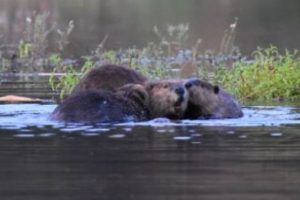Sonora, CA – State fish and wildlife officials have a status update on the translocated beavers and restoration sites, summarizing project achievements, lessons learned, and upcoming steps for beaver restoration in California.
As we reported in December 2023, the California Department of Fish and Wildlife (CDFW) launched a program to reintroduce beavers to watersheds within their original habitats across the state. Since then, these translocated beavers have begun functioning as ecosystem engineers, restoring wetlands and boosting resilience to climate impacts like drought and wildfires.
Between October 2023 and September 2024, CDFW released 28 beavers at five sites in the Sierra Nevada as part of two pilot programs developed in partnership with the Tule River Tribe in Southern California and the Maidu Summit Consortium in Northern California. The translocated beavers have since produced two litters of kits and constructed dams at three of the release locations. At the most productive site, beavers have started digging a network of canals, reconnecting the stream to its floodplain and increasing surface water by about 23%, according to the CDFW.
As part of the state’s Initiative to Expand Nature-Based Solutions, CDFW created the Beaver Restoration Program in 2022 with funding allocated by Gov. Gavin Newsom through Assembly Bill 1757. This initiative aims to better understand where, when, and how beavers—long considered pests—can be used to restore ecosystems and habitats in California. Gaining this understanding will help CDFW and the state effectively use beavers as natural tools for habitat restoration and watershed conservation.
“The Beaver Restoration Program was formed because we recognize the value that beavers can provide to a landscape,” said CDFW Beaver Restoration Program Supervisor Molly Alves. “We are putting beavers back into those portions of their historic range where they can build dams and create wetlands that protect our landscape, wildlife, and people from climate change, like drought and wildfire.”
In the Maidu Summit Consortium’s Tásmam Koyóm valley, which was ravaged by the Dixie Fire in 2021, Alves mentioned that since beavers were introduced there in October 2023, both accessible water and wetland habitats have expanded. Beavers build dams that hold deeper water, helping them avoid predators while increasing the availability and accessibility of their favorite food sources. So far, the CDFW estimates that 40–60% of the translocated beavers have survived, with the main causes of mortality being predation, illnesses like pneumonia, and capture-related stress.
“Beavers used to be everywhere, but sadly that is no longer the case,” said CDFW Director Charlton H. Bonham. “Our history treated beavers as nuisances, and we removed them from the landscape.”
In the past year, CDFW worked with the Tule River Tribe and the Maidu Summit Consortium to restore beavers to areas where they had been absent for over 100 years.
“Beavers are nature’s Swiss Army knife. The things they can do are amazing,” added Director Bonham. “We are finding in some of our scientific work that when beavers are on the landscape in the Sierra, the way they can create wet meadows serves as a firebreak that can slow down or even stop catastrophic wildfire.”
Click here for more information on the Beaver Restoration Pilot Projects in the state.

